A Duke's Guide to Seducing His Bride
Arundel Castle
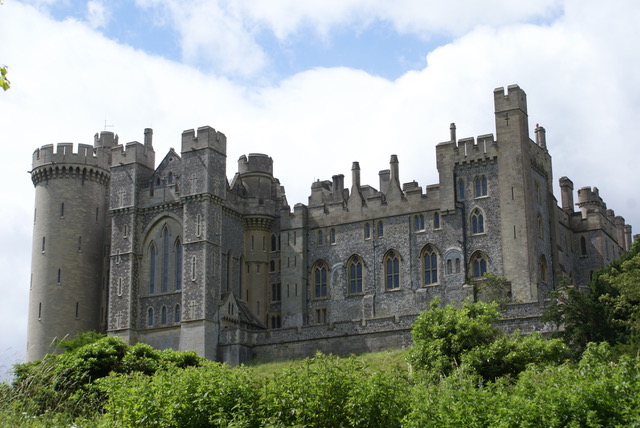
Cainewood Castle is loosely modeled on Arundel Castle in West Sussex. It has been home to the Dukes of Norfolk and their family, the Fitzalan Howards, since 1243, save for a short period during the Civil War. Although the family still resides there, portions of their magnificent home are open to visitors and more than worth a detour to gape at.
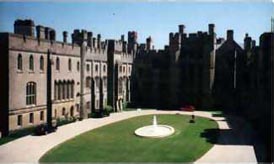 View of the quadrangle.
View of the quadrangle.
More pictures of Arundel Castle
Hatfield House
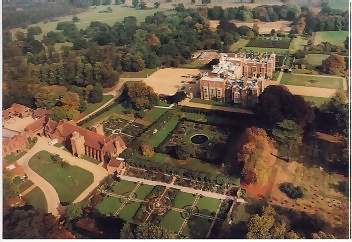 Hatfield House and gardens—aerial view.
Hatfield House and gardens—aerial view.
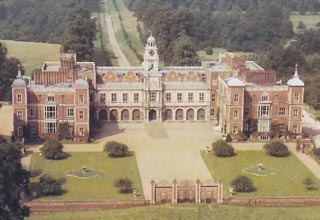 Hatfield House—note the clock tower.
Hatfield House—note the clock tower.
Though in a different geographic location, Amberley House and its beautiful gardens were loosely modeled on Hatfield House in Hertfordshire, England. The original palace, built in 1497 by the Bishop of Ely, was the childhood and young adult home of the first Queen Elizabeth. Two portraits of her can be viewed in the home today, along with some of her clothing and letters.
Elizabeth's successor, James I, did not care for Hatfield as a home, preferring Theobalds, the residence of Robert Cecil, first Earl of Salisbury. He proposed an exchange, and the Cecils agreed. In 1608, the earl tore down most of the palace and began building the present house in what was then a modern style, at a cost of over £38,000, a staggering amount of money in those times. Though first designed by Robert Lyminge, the plans were modified by others, including, it is thought, young Inigo Jones. This is the house that you can visit today, and the one Kendra saw when she first rode up that long drive.
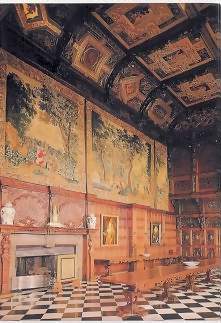 A typical, gaudy Hatfield interior—this room is still decorated as
it was in 1611 when it was used as a dining room. (Described in
A Duke's Guide to Seducing His Bride.)
A typical, gaudy Hatfield interior—this room is still decorated as
it was in 1611 when it was used as a dining room. (Described in
A Duke's Guide to Seducing His Bride.)
From the seventeenth century until present day, Hatfield House has served as both a social and political center, hosting luminaries from royalty on down. Well worth a visit, the magnificent house is open for tours from March through October, and most of the gardens are open year-round.
More pictures of Hatfield House
Borthwick Castle
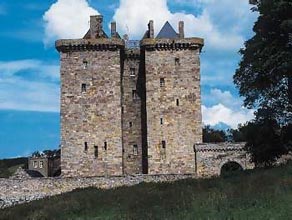 Borthwick Castle. A view from this angle was used on the cover of
A Duke's Guide to Seducing His Bride.
Borthwick Castle. A view from this angle was used on the cover of
A Duke's Guide to Seducing His Bride.
Duncraven Castle was invented when I stayed at Borthwick Castle, twin towers located just south of Edinburgh in Scotland (although, once again, I took the liberty of moving it). Built in 1430 by the first Lord Borthwick, whose sepulchre can still be seen with that of his Lady in the old village church, its virtually impregnable stone walls sheltered Mary Queen of Scots in her last days of freedom. When a force of some thousand men surrounded the castle, her husband, Bothwell, escaped, leaving Mary behind under the protection of the Borthwicks. Disguised as a page boy, Mary then climbed through a window in the Great Hall, lowered herself by rope to the ground below, and set off through the gate and across the glen in search of her husband. The stuff of romance novels, isn't it? But sadly, their reunion was a short one, and the tragic Queen never again knew real freedom.
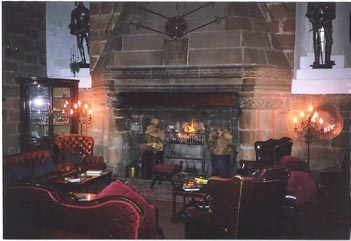 Fireplace at one end of the Great Hall.
Fireplace at one end of the Great Hall.
Nearly a century later, Borthwick Castle was besieged by the forces of
Oliver Cromwell, whose letter demanding surrender—the same one read
by Trick in my story—hangs framed in today's Great Hall. Weathered
and nobly scarred, Borthwick still stands hundreds of years later. Sir
Walter Scott described Borthwick as by far the finest example of the
Scottish castles which consist of a single donjon,
or keep. So it
was, and so it still is, now run as a bed and breakfast. Do treat yourself
with a stay there if ever you get a chance. After a delicious gourmet
dinner, you may sit before the immense fireplace, sipping spirits while
the caretakers regale you with stories of ghosts and legends. And when you
climb the winding staircase to your chamber, don't be surprised if you
find yourself looking over your shoulder…
More pictures of Borthwick Castle
World's End, Edinburgh

A sign on the wall reads: This historic pub stands on a site dating
back to the 7th century. Its name derives from the Battle of Flodden in
1513, when the Scots were beaten back by the
Auld Enemy
at Flodden
Field, whereupon the Burghers of the City decided to erect a wall
separating Edinburgh from the rest of the world. The remains of the wall
pass through the cellars below the pub, and the road outside marks where
the city ended—Thus, The World's End.
Dark and atmospheric as only an old Scottish pub can be, The World's End is a wonderfully historic place to have a meal and imagine yourself in days gone by.
Burntisland Harbor
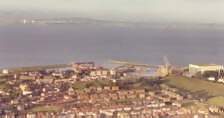 View of Burntisland and the harbor with Leith (Edinburgh) in the mists
across the Firth of Forth.
View of Burntisland and the harbor with Leith (Edinburgh) in the mists
across the Firth of Forth.
King Charles's baggage ferry really did go down in the Firth of Forth that
fated summer of 1633, although—so far as I know!—nobody had
substituted rocks for the treasure. Interestingly, the sinking wasn't
common knowledge until the early 1990s. Apparently embarrassed by the
loss, Charles did his best to keep it quiet, and it was centuries before a
historian noticed a footnote and began to look into it. Since then, three
accounts have been found that make mention of the sinking. But although
all the writers were contemporary to the incident, none of them were
actually present, and therefore, little is known about what actually lies
at the bottom of the Firth of Forth. We know that one of two wooden
ferries went down, carrying a portion of the King's household property,
but which possessions were aboard remains to be seen. It is assumed to be
mostly kitchen goods—a Royal kitchen
consisting mainly of
silver and gold serving pieces—but this is only a guess based on
accountings of replacement items that were ordered in the months afterward.
The search for the shipwreck began soon after discovery of its existence, but progress has been slow, because conditions in the Forth—frigid, choppy water, strong tides, poor visibility—severely limit diving opportunities. Early on, an American team searched for several summers, but their efforts proved unsuccessful. Following two years of inactivity, the project resumed, this time under a non-profit group formed for the purpose, Burntisland Heritage Trust. The search is being carried out in accordance with strict archaeological guidelines, and Historic Scotland is responsible for assuring that these standards are met and maintained. As of this writing, the Trust's divers have targeted an area and laid a control survey line, and their next step is to sweep search from that.
If you're interested in following the progress, news is posted regularly on Burntisland Heritage Trust's website. To learn more about the history of Burntisland and see more pictures of the area, visit the Burntisland Home Page.
Lindsey House, London
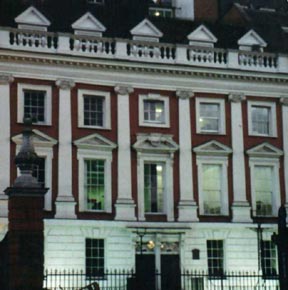
For their London town house, the Chases have borrowed Lindsey House bordering Lincoln's Inn Fields. Attributed to the esteemed architect Inigo Jones, it is the only original house left in the square. The house takes its name from Robert, 3rd Earl of Lindsey, who purchased the property in the 1660s from the family of Sir Theodore Mayerne, who had been doctor to James I and Charles I. There have been various distinguished occupants since, including James Whistler, who painted the famous portrait of his mother there.









